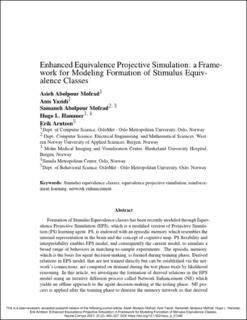| dc.contributor.author | Abolpour Mofrad, Asieh | |
| dc.contributor.author | Yazidi, Anis | |
| dc.contributor.author | Abolpour Mofrad, Samaneh | |
| dc.contributor.author | Hammer, Hugo Lewi | |
| dc.contributor.author | Arntzen, Erik | |
| dc.date.accessioned | 2021-02-03T14:02:29Z | |
| dc.date.accessioned | 2021-03-11T13:56:46Z | |
| dc.date.available | 2021-02-03T14:02:29Z | |
| dc.date.available | 2021-03-11T13:56:46Z | |
| dc.date.issued | 2021-02-01 | |
| dc.identifier.citation | Abolpour Mofrad, Yazidi, Abolpour Mofrad, Hammer, Arntzen. Enhanced Equivalence Projective Simulation: A Framework for Modeling Formation of Stimulus Equivalence Classes. Neural Computation. 2021 | en |
| dc.identifier.issn | 0899-7667 | |
| dc.identifier.issn | 1530-888X | |
| dc.identifier.uri | https://hdl.handle.net/10642/10011 | |
| dc.description.abstract | Formation of stimulus equivalence classes has been recently modeled through equivalence projective simulation (EPS), a modified version of a projective simulation (PS) learning agent. PS is endowed with an episodic memory that resembles the internal representation in the brain and the concept of cognitive maps. PS flexibility and interpretability enable the EPS model and, consequently the model we explore in this letter, to simulate a broad range of behaviors in matching-to-sample experiments. The episodic memory, the basis for agent decision making, is formed during the training phase. Derived relations in the EPS model that are not trained directly but can be established via the network's connections are computed on demand during the test phase trials by likelihood reasoning. In this letter, we investigate the formation of derived relations in the EPS model using network enhancement (NE), an iterative diffusion process, that yields an offline approach to the agent decision making at the testing phase. The NE process is applied after the training phase to denoise the memory network so that derived relations are formed in the memory network and retrieved during the testing phase. During the NE phase, indirect relations are enhanced, and the structure of episodic memory changes. This approach can also be interpreted as the agent's replay after the training phase, which is in line with recent findings in behavioral and neuroscience studies. In comparison with EPS, our model is able to model the formation of derived relations and other features such as the nodal effect in a more intrinsic manner. Decision making in the test phase is not an ad hoc computational method, but rather a retrieval and update process of the cached relations from the memory network based on the test trial. In order to study the role of parameters on agent performance, the proposed model is simulated and the results discussed through various experimental settings. | en |
| dc.language.iso | en | en |
| dc.publisher | MIT Press | en |
| dc.relation.ispartofseries | Neural Computation;Vol. 33, No. 2 | |
| dc.rights | Artikkelens aksepterte fagfellevurderte postprint-versjon er tillatt å egenarkivere i institusjonelle arkiv. | en |
| dc.subject | Stimulus equivalence classes | en |
| dc.subject | Equivalence projective simulations | en |
| dc.subject | Reinforcement learning | en |
| dc.subject | Network enhancements | en |
| dc.title | Enhanced Equivalence Projective Simulation: A Framework for Modeling Formation of Stimulus Equivalence Classes | en |
| dc.type | Journal article | en |
| dc.type | Peer reviewed | en |
| dc.date.updated | 2021-02-03T14:02:29Z | |
| dc.description.version | publishedVersion | en |
| dc.identifier.doi | https://doi.org/10.1162/neco_a_01346 | |
| dc.identifier.cristin | 1886392 | |
| dc.source.journal | Neural Computation | |
